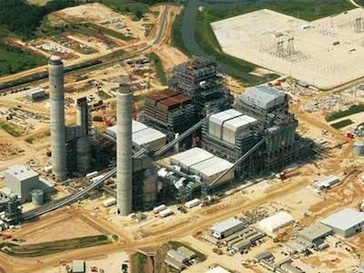
Oak Grove power plant
To counter critics’ arguments about health-threatening and climate-altering pollution, proponents of new coal-fired power plants commonly stress the economic benefits.
The promise of good-paying local jobs – especially construction jobs at the plant projects themselves – is often central to the pro-coal playbook in such debates, which have been prominent in Texas and other battlegrounds of a nationwide struggle over new coal plants.
A new national study [PDF] has found, however, that construction-job projections at most major coal plants that were built in recent years, including a pair of Texas projects, represented large overestimates.
The authors of the report, produced by the Chattanooga, Tenn.-based Ochs Center for Metropolitan Studies, said few efforts are ever made to check on such projections after a plant is built. Their study, they said, was “the first effort to look at actual economic activity resulting from the construction of large, new coal-fired power plants in the United States.”
The researchers focused on the six coal-fired plants across the country that became operational between 2005 and 2009 and have an electricity-producing capacity of more than 500 megawatts. Two of these six projects were in Texas, both owned by Dallas-based Luminant. One was the Oak Grove plant, with two generating units, in Robertson County north of Bryan-College Station. The other project added a new unit at the Sandow plant in Milam County, west of the Bryan area.
The Ochs Center researchers said overall employment grew in all six counties they evaluated, but only one, in Iowa, had a jump in construction employment while a coal plant was being built that equalled or exceeded the project’s predicted impact on local hiring. The same Iowa county also accounted for more than half of the net increase in all the counties combined, they added.
In the case of the $2.3-billion Oak Grove project in Robertson County, proponents estimated 2,400 workers would be hired for its construction. However, total construction employment in the county was up by only 329 in the peak year while the plant was being built, or 13.7 percent of the projection for the plant itself, according to the study.
Regarding the $890-million Sandow project in Milam County, construction employment of all kinds was up by 463 in the county during the peak year during that project’s construction, or 33.7 percent of the 1,370 plant-construction jobs that were forecast, the researchers reported.
In both Texas counties, the “labor retention rates” – the percentage of people employed in a county who live in that county – declined during plant construction, according to the study. There was a 19.3 percent drop in these “resident employees” in 2008 in Robertson County, compared to 2006, before plant construction began. Similarly, Milam County experienced a 17.6 percent reduction in its “resident employees” in 2008, compared to 2006, before that coal project got under way.
Regarding Sandow, the researchers wrote: “Local public officials were convinced that the project would create jobs and increase property values. Milam County Commissioner Kenneth Hollas supported the plant because of increased employment and property values, saying that ‘it’s going to be an economic aid to the county.'”
Describing their analysis of all six plants, they wrote: “These findings strongly suggest that the economic development argument for coal plants is relatively weak, especially when compared to the job creation potential of alternative means of addressing demand for power through energy efficiency.”
The New York Times reported on the study:
[The Ochs Center’s] findings seem to suggest that the trade-off that many cash-strapped communities make – specifically, accepting the health and environmental risks that come with having a new coal-burning power plant in their midst, in return for a boost in employment – is not what it’s cracked up to be.
“I think the overarching issue here is that for a lot of the communities that are being asked to host these plants, there’s an extremely difficult cost-benefit analysis that they’re being asked to make,” said David Eichenthal, the president of the Ochs Center. “They are aware of the environmental and health issues that you take on when you have a coal plant put in your backyard. But many of these communities are in dire economic straits, and it tips the balance for them to allow this to occur.”
“But what they’re being promised,” he said, “isn’t what’s being delivered.
The Chattanooga Times Free Press reported:
Luke Popovich, spokesman for the National Mining Association, did not specifically address the study’s findings. However, the loss of jobs in counties where the plants were built could well be due to the recession.
“The plant construction likely reduced the loss. I think it is standard for companies to round up on direct and indirect jobs, and underestimate plant construction costs,” he said. “I’m sure a similar study could be done on gas plants, as all have the same incentive, [and definitely wind plants].”
Luminant’s Oak Grove and Sandow projects were two of 11 coal-fired power plants that were planned several years ago by the company, then called TXU when it was under different ownership.
The 11-plant plan drew fierce opposition on the local, state and national levels. Opponents included major environmental organizations and a coalition of Texas cities including Dallas and Houston.
As part of a buyout, the company settled lawsuits by two national advocacy groups, Environmental Defense Fund and Natural Resources Defense Council. In a pre-buyout deal with those groups, the new owners agreed to drop plans for eight of the 11 plants, double the company’s spending on energy efficiency and cut its climate-changing emissions.
– Bill Dawson
